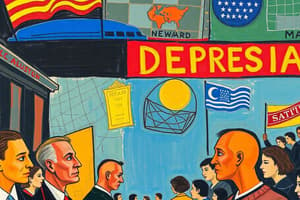Podcast
Questions and Answers
What percentage of financial institutions in the United States were closed by 1933 due to the Great Depression?
What percentage of financial institutions in the United States were closed by 1933 due to the Great Depression?
- Roughly half (correct)
- Nearly three-quarters
- Approximately one-third
- Around a quarter
How much did investments fall by during the United States' severe economic contraction between 1929 and 1932?
How much did investments fall by during the United States' severe economic contraction between 1929 and 1932?
- $25 billion
- $10 billion
- $20 billion
- $15 billion (correct)
What was the estimated number of unemployed Americans during the Great Depression?
What was the estimated number of unemployed Americans during the Great Depression?
- 18-20 million
- 8-10 million
- 13-15 million (correct)
- 5-7 million
What did historian David Kennedy suggest about Americans' beliefs regarding the Great Depression?
What did historian David Kennedy suggest about Americans' beliefs regarding the Great Depression?
What was the magnitude of the increase in the number of unemployed Americans from 1930 to 1933?
What was the magnitude of the increase in the number of unemployed Americans from 1930 to 1933?
What was the approximate percentage of unemployment reached during the Great Depression?
What was the approximate percentage of unemployment reached during the Great Depression?
What was the prevailing sentiment among Americans regarding their role in causing the Great Depression?
What was the prevailing sentiment among Americans regarding their role in causing the Great Depression?
What was the primary aim of President Franklin Roosevelt's New Deal?
What was the primary aim of President Franklin Roosevelt's New Deal?
What were 'Hoovervilles' a reflection of?
What were 'Hoovervilles' a reflection of?
What contributed to the suffering of rural areas during the Great Depression?
What contributed to the suffering of rural areas during the Great Depression?
What was a significant impact of the Great Depression on minorities?
What was a significant impact of the Great Depression on minorities?
What was the role of Eleanor Roosevelt during the Great Depression?
What was the role of Eleanor Roosevelt during the Great Depression?
What were the living conditions faced by many farmers who migrated to the Pacific coast during the Great Depression?
What were the living conditions faced by many farmers who migrated to the Pacific coast during the Great Depression?
What characterized the labor upheavals during the Great Depression?
What characterized the labor upheavals during the Great Depression?
What was the impact of reduced production on sharecroppers and tenants in the black and Hispanic communities?
What was the impact of reduced production on sharecroppers and tenants in the black and Hispanic communities?
Flashcards are hidden until you start studying
Study Notes
The Great Depression in the United States
- President Franklin Roosevelt's New Deal aimed to end the Great Depression but left most Americans struggling.
- Jobless Americans resorted to desperate measures such as waiting in long lines for daily wages and selling household items.
- Unemployment led to evictions, food shortages, and reliance on organized crime for sustenance.
- 'Hoovervilles' emerged as makeshift homes due to foreclosure and eviction, reflecting public contempt for President Herbert Hoover.
- Rural areas suffered due to protective tariffs, overproduction, and the ecological disaster known as the Dust Bowl.
- Many farmers migrated to the Pacific coast, only to face severe unemployment and unsanitary living conditions in labor camps.
- Labor upheavals, such as protests at Ford and General Motors plants, and the Memorial Day Massacre, marked the period.
- Minorities faced heightened discrimination and economic hardship, with African Americans, Hispanics, and Asians suffering the most.
- Sharecroppers and tenants in the black and Hispanic communities faced mass unemployment due to reduced production.
- Hispanics and Asians were targeted in Pacific states, leading to forced migrations and deportation.
- Civil rights were virtually non-existent, with Jim Crow laws, white unity leagues, and poll taxes curbing voting rights and perpetuating violence against African Americans.
- Eleanor Roosevelt campaigned for civil rights, providing a lone bright spot in the plight of African Americans.
Studying That Suits You
Use AI to generate personalized quizzes and flashcards to suit your learning preferences.



